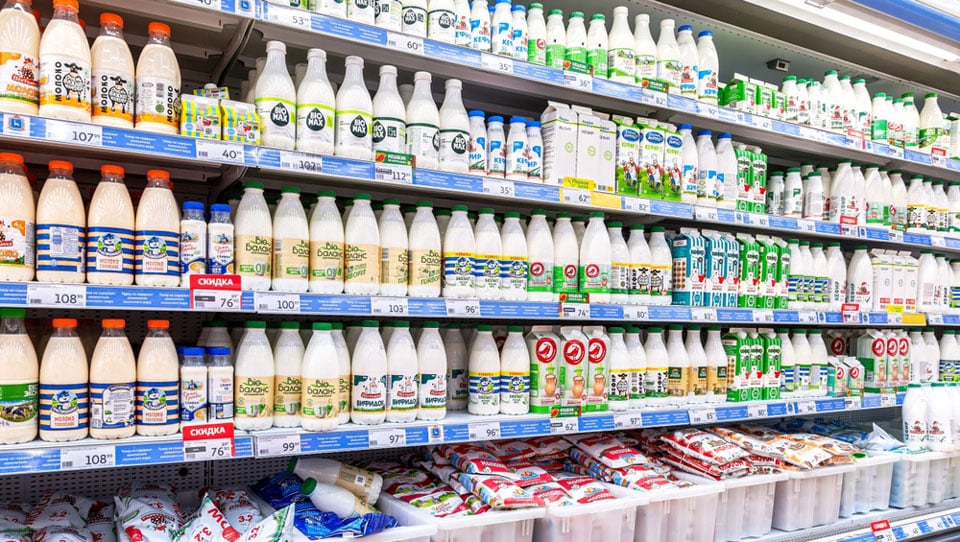Report: These Are The Most Eaten Foods in the World, 2023

This report dives deep into exploring the world’s most popular food items. By looking at both per capita consumption and production, we can learn more about the significance of these global delicacies. These beloved food items are beloved not just in one area, but all over the world, a testament to the intricate interplay of culture, economy, and history.
Rice, reigning as a global staple, is valued for its versatility and affordability, serving as a vital sustenance source worldwide. In 2022, the United States produced 164.3 million hundredweight (cwt) of rice, contributing $3.12 billion to labor income. Similarly, wheat and maize grace tables across continents due to their adaptability to diverse cuisines. Conversely, foods like quinoa and avocados, while nutritionally rich, come with a higher price tag, limiting their accessibility.
Nations heavily reliant on rice or wheat production often benefit from economies of scale, fostering agricultural stability and affordability. For instance, in the first two decades of the 21st century, China produced 2.4 billion tons of wheat, accounting for 17% of the global total. Conversely, regions dependent on expensive imported foods may face economic challenges, impacting trade balances and food security.
Consumption patterns vary by region. Potatoes are a European staple, with an average annual consumption of 90 kilograms per person. Meanwhile, cassava is prevalent in Africa, serving as a daily meal for around half a billion people.
The rise of processed foods is evident globally, driven by urbanization, shifting lifestyles, and increased availability. The share of calories from ultra-processed foods has grown from 53.5% to 57%, while calories from whole foods have decreased from 32.7% to 27.4% in the past two decades.
In the food industry, pasta stands out, with the American Italian Pasta Company as a major player in North America, offering an array of pasta varieties. Kraft Heinz, one of the world’s largest food and beverage manufacturers, seeks to tap into a $25 billion opportunity in the education sector, focusing on school meal staples like pasta and hamburgers. Looking ahead, Kraft Heinz aims for substantial organic sales growth of 5% in its food-service division, in contrast to the expected 1% to 2% growth in the US retail sector.
Our ranking of the world’s most consumed foods is based on two key metrics: Per Capita Consumption (weighted at 70%) and Per Capita Production (weighted at 30%). By assigning specific weights to each metric, we calculated weighted averages to determine the relative significance of each criterion.
These Are The Most Eaten Foods in the World, 2023
- Milk:
Per Capita Consumption (KG): 79.3
The top 5 milk-producing countries in the world are India, the United States, China, Pakistan, and Brazil.
Over the past thirty years, global milk production has seen substantial growth, increasing by over 59%.
In 2019, global milk production reached 881 million tons, and per capita consumption of dairy products rose to 114.7 kilograms.
The dairy industry holds significant economic importance in the United States, contributing $49 billion in direct economic impact. - Rice:
Per Capita Consumption (KG): 78.4
Rice, a fundamental crop, is cultivated across 158 million hectares yearly.
It holds a unique position in the developing world, with its production value twice that of any other food crop.
Rice serves as a fundamental food source in numerous Asian markets.
The prices of rice significantly impact food price inflation and food security, particularly for economically disadvantaged households.
The average price of rice is $17.30 per hundredweight (cwt), projected to decrease to $14.50 per cwt in 2024.
It is anticipated that rice prices will continue to remain elevated until 2024. - Wheat:
Per Capita Consumption (KG): 67
Wheat is cultivated in over 170 countries and serves as a staple food for billions.
China, India, and the European Union are the top three wheat producers.
Russia stood out as the top exporter of wheat in 2021, with a total value of $8.92 billion.
In 2022, China yielded approximately 136.9 million tons of wheat. - Potatoes:
Per Capita Consumption (KG): 32.9
Potatoes, first domesticated by indigenous peoples of the Andes mountains in South America, are rich in carbohydrates, dietary fiber, potassium, and vitamin C.
They are low in fat and calories.
In 2021, the world impressively produced 101 billion tons of potatoes, indicating their widespread cultivation in over 100 countries worldwide. - Tomatoes:
Per Capita Consumption (KG): 21.2
Tomatoes, originating in Central and Western South America, possess a global market value estimated at $181.74 billion in 2022.
The market is projected to reach $273.2 billion by 2031, experiencing a compound annual growth rate (CAGR) of 4.635% during the forecast period (2023-2031).
Notably, in the United States, the total value of fresh and processed tomatoes produced in 2015 was $1.22 billion and $1.39 billion, respectively. - Maize:
Per Capita Consumption (KG): 18.2
Maize is a vital staple food for millions, with the United States, China, Brazil, Mexico, and India as the primary producers.
It is a significant source of carbohydrates and calories for human consumption.
Maize is also utilized in the production of various industrial products, including plastics, adhesives, and cosmetics.
In the marketing year of 2022/23, there was a reduction of 45 million bushels in maize usage. - Sugar:
Per Capita Consumption (KG): 20.4
Leading sugar-producing countries comprise Brazil, India, Thailand, China, and the United States.
Sugar is a versatile ingredient used in various food products, including candy, baked goods, and soft drinks, as well as in industrial applications like ethanol and biofuel production.
The industrial sugar market is expected to reach a value of USD 59.1 billion by 2028, demonstrating growth from its 2023 value of USD 46.4 billion.
Notably, sugar prices have experienced a decline in recent years, reaching levels reminiscent of those observed in the mid-2000s. - Seafood:
Per Capita Consumption (KG): 20.2
Seafood is cherished globally for its delicious taste and versatility in various cuisines, from sushi in Japan to shrimp scampi in Italy.
It serves as a vital source of protein and essential nutrients like Omega-3 fatty acids, known for promoting heart and brain health.
Major seafood-producing nations include China, Indonesia, India, Vietnam, and the United States.
Notably, in 2022, retailers in the United States sold 696 million pounds of fresh seafood, marking an increase of 14 million pounds compared to 2019. - Cassava:
Per Capita Consumption (KG): 15.3
Cassava is a starchy, tuberous crop of significant importance in Africa, Asia, and South America.
Leading cassava producers include Nigeria, Indonesia, Thailand, and Brazil.
It is consumed fresh or processed into products such as flour, chips, or tapioca.
The cassava market was valued at $175.9 billion in 2022 and is projected to grow to $254.28 billion by 2032, with a 4.18% annual growth rate.
This growth is attributed to increased demand for cassava starch in the food and beverage industry, its use in sweetener production, and its high usage in snacks and cereals. - Meat, Chicken:
Per Capita Consumption (KG): 15.6
Chicken is a staple protein source globally, with the United States, China, Brazil, and India as leading producers.
It’s versatile in various culinary dishes, from fried chicken to stews and sandwiches.
Notably, in 2021, the value of chicken sales amounted to $14.9 million, reflecting a 20% decrease from 2020. - Pulses:
Per Capita Consumption (KG): 18.1
Pulses are a group of leguminous crops known for their edible seeds, providing protein, fiber, and nutrients.
From 2011 to 2021, global egg production grew from 65.5 to 86.4 million tons.
Leading pulse producers include India, China, and Canada. - Meat, Pig:
Per Capita Consumption (KG): 15.6
Pig meat is one of the most consumed meats globally, following poultry.
Leading pig meat producers include China, the European Union, and the United States.
It is a good source of protein, iron, and zinc, and it is low in saturated fat.
Developed countries’ share of global pig meat production is expected to decline from 39.6% to 36.7% by 2031 while developing countries’ share will rise to 63.3%. - Bananas:
Per Capita Consumption (KG): 11.9
Bananas, rich in potassium, vitamin C, and fiber, grow in tropical and subtropical regions worldwide.
India, China, and the Philippines are the top producers of bananas.
In 2022, global net banana imports decreased by 5.8%, with 1.1 million tons fewer bananas imported compared to the previous year. - Onions:
Per Capita Consumption (KG): 11.8
Onions, a staple vegetable crop, are cultivated worldwide, with leading producers including China, India, the United States, and Russia.
They are versatile in numerous cuisines, enhancing the flavor of soups, salads, and stir-fries.
In 2022, the global fresh onions market was valued at $53.42 billion. - Oranges:
Per Capita Consumption (KG): 12
Oranges are primarily grown in countries with warm climates, including the United States (especially in Florida and California), Brazil, Spain, and China.
During the COVID-19 pandemic, U.S. orange juice sales peaked at 44.5 million gallons in 2020.
U.S. orange production was forecasted to fall by 26% to 2.3 million tons in 2022/23, marking the lowest level since 1966. - Sorghum:
Per Capita Consumption (KG): 15.2
Sorghum, cultivated predominantly in countries like the United States, Nigeria, India, and Sudan, is known for its drought-resistant nature.
The global sorghum market increased from $1.85 billion in 2022 to $1.99 billion in 2023, with a CAGR of 7.21. - Eggs:
Per Capita Consumption (KG): 9.7
In 2022, the Netherlands led in egg exports with an export value of $534.01 million, followed by Poland and Turkey.
The egg industry is valued at $10 billion, with a 13% annual profit growth from 2017 to 2022.
China is the leading producer of eggs, followed by India, the United States, and Russia. - Apples:
Per Capita Consumption (KG): 9
China, with 29,669 kilotons, was the top apple-consuming country in 2020, followed by the USA and Turkey.
Apples are rich in fiber, vitamin C, and other nutrients, making them suitable for fresh consumption or processing into various products such as juice and cider. - Sweet Potatoes:
Per Capita Consumption (KG): 6.9
Sweet potatoes are a nutritious and versatile food produced in large quantities globally.
China is the leading producer and consumer of sweet potatoes, which are used for various purposes, including food, animal feed, and processing into food, starch, and other products. - Cattle Fat:
Per Capita Consumption (KG): 9.1
Cattle fat is a white, solid fat used in products such as margarine, shortening, and soap.
Leading cattle fat producers include India, Brazil, China, and the United States.
It is also used to make lard, a type of cooking fat.
The global beef market is forecasted to expand from $414.98 billion in 2022 to $604.34 billion by 2029. - Barley:
Per Capita Consumption (KG): 9.1
Barley is a versatile grain used in various dishes, including beer, bread, and breakfast cereals.
In 2021/2022, 54 countries purchased 424,000 metric tons of American barley.
The starch in barley is converted into sugars during brewing, a critical step in beer production. - Watermelons:
Per Capita Consumption (KG): 1.07
Watermelons, native to Africa, are rich in vitamins A and C and lycopene, an antioxidant associated with reduced cancer risk.
In 2021, the United States produced watermelons worth $534 million, with a total production of 34.1 million hundredweight (cwt). - Grapes:
Per Capita Consumption (KG): 4.25
Grapes are not only used for fresh consumption but also winemaking, making them a valuable export crop.
Leading grape producers include China, Italy, France, Spain, the United States, Turkey, and Argentina.
Portugal is anticipated to see a 40% increase in grape exports. - Yams:
Per Capita Consumption (KG): 5.2
Yams are vital food crops grown in tropical regions of Africa, Asia, the Caribbean, and South America.
In November 2022, yams were priced at $1589 per ton in the USA.
Brands like Del Monte, Goya, and Dole offer yam products. - Mangoes:
Per Capita Consumption (KG): 3.6
Mangoes, native to South Asia, are grown in over 100 countries.
Leading mango producers include India, China, Mexico, Indonesia, and Thailand.
The mango market is projected to grow from $57,332.9 million in 2021 to $77,942.1 million in 2026, with an expected CAGR of 8.0% starting from 2026, reaching $114,685.2 million in 2031.
The world’s most consumed foods reflect diverse diets and economic significance. Regional preferences persist, with foods like potatoes in Europe and cassava in Africa, Asia, and South America. Seafood is universally appreciated. Economically, sectors like sugar and cassava anticipate growth, while dairy boosts economies like the United States. Balanced dietary choices are vital in the face of changing lifestyles. Sustainability in agriculture is key for future food security, underscoring the complex interplay of history, culture, economics, and nutrition in our world.
Have you read?
Here Are 29 Inspirational Women CEOs Making An Impact, 2023.
Countries With The Most Billionaires, 2023.
The Exclusive $100 Billion Club (And How They Made Their Fortune).
Africa’s Billionaires 2023: Who Are the Richest People in Africa?
The 10 Female CEOs in FTSE 100 companies in the United Kingdom, 2023.
Add CEOWORLD magazine to your Google News feed.
Follow CEOWORLD magazine headlines on: Google News, LinkedIn, Twitter, and Facebook.
This report/news/ranking/statistics has been prepared only for general guidance on matters of interest and does not constitute professional advice. You should not act upon the information contained in this publication without obtaining specific professional advice. No representation or warranty (express or implied) is given as to the accuracy or completeness of the information contained in this publication, and, to the extent permitted by law, CEOWORLD magazine does not accept or assume any liability, responsibility or duty of care for any consequences of you or anyone else acting, or refraining to act, in reliance on the information contained in this publication or for any decision based on it.
Copyright 2024 The CEOWORLD magazine. All rights reserved. This material (and any extract from it) must not be copied, redistributed or placed on any website, without CEOWORLD magazine' prior written consent. For media queries, please contact: info@ceoworld.biz
SUBSCRIBE NEWSLETTER








